Alfredo Álvarez Plágaro
Work of art by Alfredo Álvarez Plágaro
Madrid-based artist Alfredo Álvarez Plágaro (* 1960 Vitoria-Gasteiz, Spain) calls his works Identical Paintings. They consist of several paintings, sometimes up to a hundred of the same size, created with mixed media on canvas and wood, which develop simultaneously in the artistic process. Plágaro does not finish one painting and then copy it, but works on the entire series in parallel. Installed together, an overall picture emerges that condenses into a shimmering pattern or allows for distant motivic associations.
Statement
”If repetition exists, then it opposes singularity contra the general, the genaral contra the particular,
the special contra the normal, the momentum contra the changing, eternity contra permanence. "
Gilles Deleuze Diferencia y repetición
Statement
”If repetition exists, then it opposes singularity contra the general, the genaral contra the particular,
the special contra the normal, the momentum contra the changing, eternity contra permanence. "
Gilles Deleuze Diferencia y repetición

Variations
Identical Paintings, 2001
mixed media
50 parts, each 255 x 7 x 5 cm
Identical Paintings, 2001
mixed media
50 parts, each 255 x 7 x 5 cm
IDENTICAL PAINTINGS
First works of Cuadros Iguales were created at the end of the 80's. They do not present a rupture concerning earlier works, they are only the result of a fast development which radically changed my artistic concept. Since then, the following statement is characteristic to my work: "The most important is not what it is, but that what it is, it is repeatedly." By this I want to stress that repetition has become my most important motiv of my artistic will.
First works of Cuadros Iguales were created at the end of the 80's. They do not present a rupture concerning earlier works, they are only the result of a fast development which radically changed my artistic concept. Since then, the following statement is characteristic to my work: "The most important is not what it is, but that what it is, it is repeatedly." By this I want to stress that repetition has become my most important motiv of my artistic will.
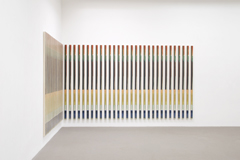
Out of my own free will I limit my own liberty by applying the instrument of repetition and feel - in a paradox way - even more free. Although my paintings allow me endless possibilities and liberty, I limit myself, I draw myself back, in order to be able to repeat it in another painting. In my paintings I repeat by intention the "unsuccesful" and the "successful". By this repetition the meaning of both value categories changes. I think that by this, through the repetition, the climax becomes more evident and the idea becomes figurative and visible; loss is a minimum. I was never interested in pretending repetition, this means that in my work series Identical paintings I never intended to create some kind of differences. Theses differences emerge by themselves.
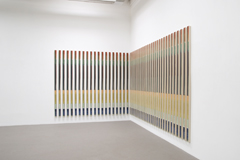
I want to stress that I do not finish one painting and then copy it. I work parallel on the whole serie (my paintings are not cloned, they are developped as twins in a parallel way). Therefore, the number of single paintings for one series is limited and cannot be enlarged. The repetition is created without mechanical means of help.
One interesting aspect of this series is that that because of the repetition the observer is forced to look back to the painting before. Thanks to the repeated paintings, every single painting becomes analyzed in a deeper way: you must look at each single painting several times. The look wanders from one work to the other and goes back again. As in a play, the observer can search the inevitable difference in the equal.
One interesting aspect of this series is that that because of the repetition the observer is forced to look back to the painting before. Thanks to the repeated paintings, every single painting becomes analyzed in a deeper way: you must look at each single painting several times. The look wanders from one work to the other and goes back again. As in a play, the observer can search the inevitable difference in the equal.
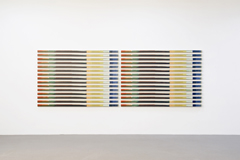
The inspiring source for my paintings is the Dadaism. Not knowing this, can lead to misunderstandings of my paintings. Repetition is one nature of humour and irony. Reptetition also means corsses borders. With my "Identical paintings" I break the concept of original/ unique paintings and its copies. Each of my series of "Identical paintings" are identical and at the same time not identical. I ask myself it this is adding value to my paintings or not. Does two identical paintings of the series "Las Maninas" by Velázquez, which have been painted at the same time, find more or less interest than one single painting?
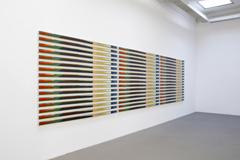
I would like to stress that since 2003 my works have gone through an important process of synthesis, regarding 3 mayor aspects. First, I don´t paint in colours anymore, but black and white. Second, the technical process (and the corresponding surface structures) has been simplified to one single step: putting on dilute acrylic on a very smooth and absorbent surface. Third, the number of repetitions per series has been reduced radically.
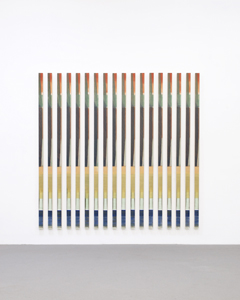
In my exhibition I play principally with the format of the paintings, the size and the amount of paintings per series. For me, the installation of the exhibition is the last creative act by which I intend to create the most harmonic atmosphere between paintings and space. There are a lot of possibilities how to install my series (one painting beside another, one over another or as a group) as well as each single work, because my works do not have a predetermind position in order to be seen (my painting cannot be installed "the other way around", nore "in the right way", as it can be hanged on all four corners). For this reason, even with my series "Identical paintings" I can install totally different exhibitions.
The outcome of my works depend on a high percentage on coincidence. My works never know which direction they will take and in the most of the cases I do not agree with the direction they are taking. I am much more interested in knowing how I came to where I am and what motivates me to developp new perspectives one´s when I arrived where I was. So, every painting is an expression of one more step in this process of creating arts.
Alfredo Álvarez Plágaro
The outcome of my works depend on a high percentage on coincidence. My works never know which direction they will take and in the most of the cases I do not agree with the direction they are taking. I am much more interested in knowing how I came to where I am and what motivates me to developp new perspectives one´s when I arrived where I was. So, every painting is an expression of one more step in this process of creating arts.
Alfredo Álvarez Plágaro
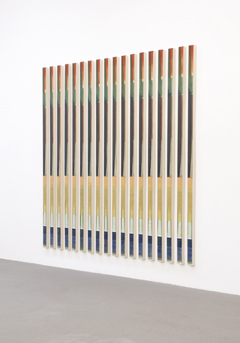
CUADROS IGUALES
”Si la repetición existe, expresa a la vez una singularidad contra lo general, una universalidad contra lo particular, un extraordinario contra lo ordinario, una instantaneidad contra la variación, una eternidad contra la permanencia.”
Gilles Deluze Diferencia y repetición
Los Cuadros Iguales surgieron a finales de los años 80. No hubo una ruptura con la obra anterior sino simplemente una evolución acelerada que cambió radicalmente el concepto de mi pintura. A partir de entonces el siguiente postulado conforma mi obra; ¨Lo más importante no es lo que es sino que lo que es lo es varias veces¨. Es decir, convierto a la repetición en el ¨motivo¨ más importante de mi voluntad creativa.
Desde mi libertad, por medio de la repetición, limito mi propia libertad y, paradójicamente, ello me hace sentirme más libre. Pudiendo hacer de todo en ese ¨infinito¨ que es un cuadro me limito, me contengo, a ir repitiendo lo que voy haciendo simultáneamente en otro. En mis cuadros repito conscientemente el ¨fallo¨ y el ¨acierto¨ con lo que tanto el uno como el otro cambian su significación. Considero que de este modo, por medio de la repetición, la anécdota se supera y la idea se concreta mejor, se devalúa menos. Nunca me ha interesado la ¨pseudorepetición¨; en mis series de ¨Cuadros Iguales¨ no busco crear diferencias en absoluto, en todo caso ellas se crean solas.
Es necesario resaltar que no acabo un cuadro y lo copio, sino que realizo la serie en su conjunto (no son cuadros clonificados sino que surgen de una gestación gemelar.) El número de unidades de la serie, por tanto, esta limitado desde el principio y no se puede ampliar. Por supuesto nunca hay una repetición mecánica.
Una cosa interesante de estas series es que al ser repetidas obligan a remirar lo visto anteriormente. Un cuadro independiente, gracias a sus idénticos, es visto con mayor profundidad, es como ver el mismo cuadro varias veces. La mirada pasa de uno a otro y viceversa. El espectador, como en un juego, puede buscar la inevitable diferencia de la igualdad.
El germen de mi pintura tiene un espíritu Dadaísta: no saberlo puede perturbar su entendimiento. La repetición es propia del humor y de la ironía. Es transgresión. Con mis ¨Cuadros Iguales¨ rompo con lo que es obra única, original y con lo que no lo es. Cada cuadro de una serie de ¨Cuadros Iguales¨ son, y no son al mismo tiempo, obras únicas. Me pregunto si eso da más valor a cada cuadro o se lo quita. ¿Dos cuadros iguales de ¨Las Meninas¨ pintados al mismo tiempo y simultáneamente por Velázquez tendrían mayor o menos interés que uno sólo?
Debo de señalar que desde 2003 mi obra ha tenido un importante proceso de síntesis en tres aspectos: he pasado del color al blanco y negro, los procesos técnicos (y sus consiguientes texturas) se han simplificado a uno solo de aguadas de acrílico sobre una base lisa muy absorbente y el número de repeticiones por serie se ha ido reduciendo ostensiblemente.
En mis exposiciones juego principalmente con el formato de los cuadros, con su tamaño y con el número de unidades de cada serie. Para mí el montaje de una exposición es el último acto creativo. El objetivo es ¨mezclar¨ los cuadros y el espacio de la manera más armónica posible. Esta obra tiene una gran cantidad de posibilidades de instalación debido a que los cuadros no tienen una posición determinada para ser vistos (un cuadro mío nunca puede estar ¨al revés¨ ni tampoco ¨al derecho¨, se puede colgar de los cuatro lados) y a que las series se pueden instalar de muchas maneras (unos junto a otros, encima de otros o formando grupos.) Con las mismas series de ¨Cuadros Iguales¨ puedo crear exposiciones totalmente diferentes.
Mi obra esta conformada por lo accidental en un porcentaje muy alto, es ignorante de su dirección y, casi siempre, estoy en desacuerdo de por donde va. Me interesa lo que me ha hecho llegar a donde estoy y lo que me va a hacer despegarme de ello, cada cuadro es una huella de este viaje.
Alfredo Álvarez Plágaro
”Si la repetición existe, expresa a la vez una singularidad contra lo general, una universalidad contra lo particular, un extraordinario contra lo ordinario, una instantaneidad contra la variación, una eternidad contra la permanencia.”
Gilles Deluze Diferencia y repetición
Los Cuadros Iguales surgieron a finales de los años 80. No hubo una ruptura con la obra anterior sino simplemente una evolución acelerada que cambió radicalmente el concepto de mi pintura. A partir de entonces el siguiente postulado conforma mi obra; ¨Lo más importante no es lo que es sino que lo que es lo es varias veces¨. Es decir, convierto a la repetición en el ¨motivo¨ más importante de mi voluntad creativa.
Desde mi libertad, por medio de la repetición, limito mi propia libertad y, paradójicamente, ello me hace sentirme más libre. Pudiendo hacer de todo en ese ¨infinito¨ que es un cuadro me limito, me contengo, a ir repitiendo lo que voy haciendo simultáneamente en otro. En mis cuadros repito conscientemente el ¨fallo¨ y el ¨acierto¨ con lo que tanto el uno como el otro cambian su significación. Considero que de este modo, por medio de la repetición, la anécdota se supera y la idea se concreta mejor, se devalúa menos. Nunca me ha interesado la ¨pseudorepetición¨; en mis series de ¨Cuadros Iguales¨ no busco crear diferencias en absoluto, en todo caso ellas se crean solas.
Es necesario resaltar que no acabo un cuadro y lo copio, sino que realizo la serie en su conjunto (no son cuadros clonificados sino que surgen de una gestación gemelar.) El número de unidades de la serie, por tanto, esta limitado desde el principio y no se puede ampliar. Por supuesto nunca hay una repetición mecánica.
Una cosa interesante de estas series es que al ser repetidas obligan a remirar lo visto anteriormente. Un cuadro independiente, gracias a sus idénticos, es visto con mayor profundidad, es como ver el mismo cuadro varias veces. La mirada pasa de uno a otro y viceversa. El espectador, como en un juego, puede buscar la inevitable diferencia de la igualdad.
El germen de mi pintura tiene un espíritu Dadaísta: no saberlo puede perturbar su entendimiento. La repetición es propia del humor y de la ironía. Es transgresión. Con mis ¨Cuadros Iguales¨ rompo con lo que es obra única, original y con lo que no lo es. Cada cuadro de una serie de ¨Cuadros Iguales¨ son, y no son al mismo tiempo, obras únicas. Me pregunto si eso da más valor a cada cuadro o se lo quita. ¿Dos cuadros iguales de ¨Las Meninas¨ pintados al mismo tiempo y simultáneamente por Velázquez tendrían mayor o menos interés que uno sólo?
Debo de señalar que desde 2003 mi obra ha tenido un importante proceso de síntesis en tres aspectos: he pasado del color al blanco y negro, los procesos técnicos (y sus consiguientes texturas) se han simplificado a uno solo de aguadas de acrílico sobre una base lisa muy absorbente y el número de repeticiones por serie se ha ido reduciendo ostensiblemente.
En mis exposiciones juego principalmente con el formato de los cuadros, con su tamaño y con el número de unidades de cada serie. Para mí el montaje de una exposición es el último acto creativo. El objetivo es ¨mezclar¨ los cuadros y el espacio de la manera más armónica posible. Esta obra tiene una gran cantidad de posibilidades de instalación debido a que los cuadros no tienen una posición determinada para ser vistos (un cuadro mío nunca puede estar ¨al revés¨ ni tampoco ¨al derecho¨, se puede colgar de los cuatro lados) y a que las series se pueden instalar de muchas maneras (unos junto a otros, encima de otros o formando grupos.) Con las mismas series de ¨Cuadros Iguales¨ puedo crear exposiciones totalmente diferentes.
Mi obra esta conformada por lo accidental en un porcentaje muy alto, es ignorante de su dirección y, casi siempre, estoy en desacuerdo de por donde va. Me interesa lo que me ha hecho llegar a donde estoy y lo que me va a hacer despegarme de ello, cada cuadro es una huella de este viaje.
Alfredo Álvarez Plágaro
